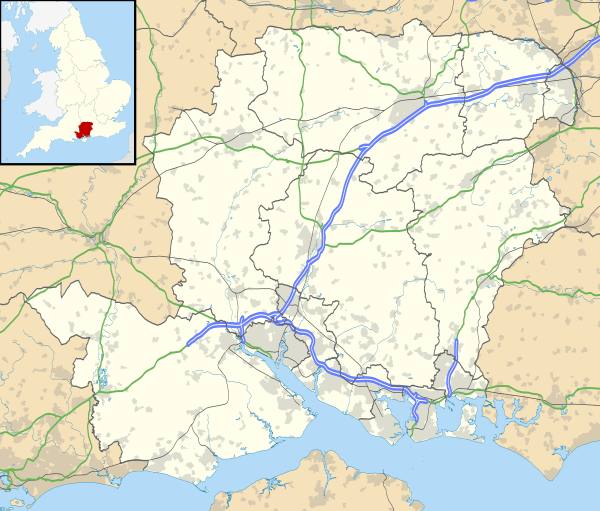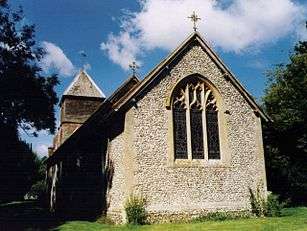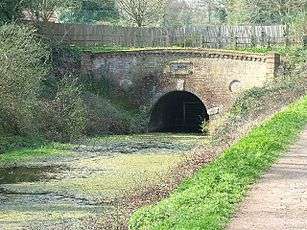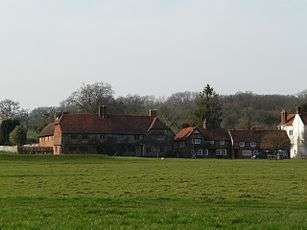Greywell
| Greywell | |
|---|---|
 Greywell Greywell shown within Hampshire | |
| Population | 237 (2011 Census)[1] |
| OS grid reference | SU7159750982 |
| Civil parish |
|
| District | |
| Shire county | |
| Region | |
| Country | England |
| Sovereign state | United Kingdom |
| Post town | HOOK |
| Postcode district | RG29 |
| Dialling code | 01256 |
| Police | Hampshire |
| Fire | Hampshire |
| Ambulance | South Central |
| EU Parliament | South East England |
| UK Parliament | |
Greywell is a small village and civil parish in Hampshire, England. The village is a past winner of the Best Kept Village in Hampshire competition and a recent winner of Best Small Village in Hampshire.[2]
Greywell is situated on the west bank of the River Whitewater, 6 miles east of Basingstoke and 1.5 miles west of Odiham. The area is extremely popular with walkers and cyclists. Many photographers also visit the village, taking pictures of some of the local architecture. There are 29 Grade II listed buildings or entries in the area, and 2 Grade II* listed buildings.[3] The nearby medieval Odiham Castle is of historical interest to many. At the centre of the village is the Fox and Goose public house.
History
The village was not recorded in the Domesday Book, possibly being considered part of the manor of Odiham instead.[3] Becoming a separate manor in the 13th century, it was sold to Guy Carleton, 1st Baron Dorchester, and the first Governor General of Canada in 1786, and it has stayed in the family ever since.
Originally a Saxon hunting settlement, the village’s economy is rooted in agriculture and more latterly timber, which flourished at the same time as the Basingstoke Canal, which was built at the end of the 18th century. It runs through and under Greywell. However, the canal was never a commercial success and was soon overtaken by the advent of the railway; by the turn of the last century it had fallen into disuse. These days, whilst agriculture remains the most important local industry, most residents of the village work elsewhere, commute to London or are retired.
Greywell Hill House
In the 17th century, Nateley and Greywell manors were owned by the Zouche family of Bramshill, then the Henleys of Northington Grange. The 876 acres of Greywell Manor were bought in 1787 by Guy Carleton, 1st Baron Dorchester, former Governor General of Quebec. Trustees who purchased the Manor for Guy Carleton described it as ‘A delightful spot …charming hills much woods, good water, a small river in the bottom with good Trout….the Farm buildings in most excellent condition’.
There were three farms in the Manor, of which Grewell Farm was probably the least significant. An estate survey of 1788 shows the line of the tunnel for the Basingstoke Canal which crosses the north of the estate. The farm was tenanted, Guy Carleton choosing to live at Kempshott nearby and then in Middlesex. He died in 1808 and it was not until around 1824 when the farm had become a gentleman’s residence that Arthur Henry Carleton, 2nd Lord Dorchester, finally moved in.
The Greenwood map, 1826, indicates that a formal garden has been started and it is clear that a gentleman’s residence would have had pleasure grounds as well. The Tithe map of 1842 shows a mansion, approach drive, stable block, grounds and a surrounding park. The 1st edition OS maps show a partly walled kitchen garden as well as lawns and features such as a fountain and a pond. An old chalk pit to the east of the approach drive has become The Dell. Footpaths lead through the park and there has been much planting of trees in the parkland. An article in the Gardeners’ Chronicle, 1907, indicates that the period 1870s-90s there was a great deal of planting both of plants and trees. A Dutch garden is described in what was originally the chalk pit (shown on early, old maps).
The title of Lord Dorchester became extinct in 1897 but Henrietta Anne Carleton (by now Mrs Leir-Carleton), daughter of the last Lord Dorchester, applied for the reinstatement of the title which was granted by Queen Victoria in 1899. Henrietta then became the 1st Baroness Dorchester. In its turn, this title became extinct in 1963 when Henrietta’s son from her first marriage to Francis Paynton Pigott, died. However, their daughter had already married William James Harris, 6th Earl of Malmesbury. In 2000, William James Harris died and James Carleton Harris became 7th Earl of Malmesbury thus a direct heir of Guy Carleton, 1st Baron Dorchester. He is the current owner of Greywell Hill House.
St. Mary's Church
Greywell’s church, dedicated to St Mary the Virgin, is an ancient structure of flint with stone quoins and dressings in the Norman and early English styles. It consists of a chancel, nave, porch and tower surmounted by wooden belfry containing four bells.
At the time of the Domesday Survey in 1086 it is thought that the Chapel of St.Mary, beside the Whitewater, was one of the two churches within the Manor of Odiham mentioned in the survey. The church is of Norman origin and was built in the 12th century.

Restored in 1870, it still boasts many old features, the most important of which is the early 16th century rood-screen, made of carved oak which before the restoration was used as a men’s gallery with rood loft and circular stairs. The narrow 13th Century Early English chancel-arch is also a prominent feature and one will also find, on the stonework to the left outside the church door, visible remains of several consecration crosses dating back to the period of the Crusades. Church Cottage, beside the lych-gate on The Street, is believed to have been originally the priest's lodgings. St Mary’s Church in Greywell is part of the United Parish of Newnham with Nately Scures with Mapledurwell with Up Nately with Greywell, which in turn is part of the North Hampshire Downs Benefice in the Church of England Diocese of Winchester.
Greywell is within the Anglican United Parish which is served by St Swithun's, Nately Scures.
Greywell Tunnel
The Basingstoke Canal runs underneath part of the village through the 1.1 km long Greywell Tunnel which is now no longer navigable due to a collapse which occurred in 1932. The eastern portal in Greywell village is the largest winter bat roost in the country, and the second largest colony of Natterer's bat in Europe.[4] The canal originally ran from Basingstoke to join the Wey Navigation near Pyrford. However the canal is derelict towards Basingstoke and only starts being navigable a mile or so to the east of Greywell tunnel and then runs towards North Warnborough, passing the ruins of King John's castle. A short section of the canal from the western tunnel portal exists and is a nature reserve and the original towpath can be walked. Greywell is home to two Sites of Special Scientific Interest, with the Greywell Tunnel and its bat colony, and Greywell Moors.
The Basingstoke Canal was authorised by an Act of Parliament obtained in 1778. The company was authorised to raise £86,000 by issuing shares, and an additional £40,000 if required. The route was around 44 miles (71 km) long, running from Basingstoke to the Wey and Godalming Navigations near Weybridge, with a large loop running to the north to pass around Greywell Hill. The loop cut through the grounds of Tylney Hall, owned by Earl Tylney, and he objected to the route. At the time, the American Revolutionary War was in progress, and no construction took place for some time. Finally, a favourable forecast of expected traffic was published in 1787, and the committee took action. A survey was made by William Jessop, who was appointed as engineer, and the contract for construction was awarded to John Pinkerton, part of a family of contractors who often worked with Jessop, in August 1788.
The route was changed, with the large contour-following route which had been surveyed around Greywell Hill being replaced by a tunnel through it, cutting nearly 7 miles (11 km) from the length of the canal. Construction started in October 1788, although Pinkerton was not initially responsible for the tunnel, the contract for which was awarded to Charles Jones. Jones had been dismissed by the Thames and Severn Canal company in 1788, after failing to complete the Sapperton Tunnel project. In his defence, he had been asked to build it bigger than originally specified and line it with bricks at no extra cost. He worked on Greywell Tunnel, but was again dismissed in 1789. Pinkerton had complained constantly about him. It is not clear whether Pinkerton supervised the cutting of the tunnel, but in 1789 the company sacked its brickmaker, and in 1790 required Pinkerton to ensure that the quality of the brick was adequate for the tunnel work. 223 yards (204 m) of tunnel had been completed by June 1791, and by November 1792 a similar distance was left to be completed.

The canal was opened on 4 September 1794, but two sections of the bank collapsed shortly afterwards, and parts of it were closed until the summer of 1795. The quality of the work on the tunnel was also criticised. The tunnel had no towpath so boats had to be taken through by legging, taking up to six hours to pass through the tunnel. The gated and locked western end of the tunnel, in late 2013. The former portal and a short section of the tunnel has collapsed into the canal and become overgrown.
Trade on the canal was never as intensive as had been predicted, and several companies attempted to run it, but each ended up bankrupt. The last successful passage through the tunnel was probably in 1914 by the barge Basingstoke owned by Mr A J Harmsworth, carrying sand. The intention of this trip was to prove, at the request of the then owner of the canal, that it was still navigable and so avoid the possibility of closure under the Railway and Canal Traffic Act 1888. Harmsworth, the last trader working on the canal, bought the canal in 1923, but only the lower section up to Woking was used. The tunnel was finally closed when part of the roof collapsed in 1932, after which the canal to the west, including Basingstoke Wharf, was sold. It was still possible for canoeists to get through the tunnel until the late 1950s, but the blockage is now total.
Notable residents
- Thomas Dawson, Driver, Army Service Corps[5][6]
- James Carleton Harris, 7th Earl of Malmesbury
- Lady Nell Carleton Harris
- Bill Newton Dunn (Politician)
- Richard Noble (Entrepreneur)
- Nick Jeffery, CEO of Vodafone UK
Further reading
- Rupert Willoughby Greywell: Church and Village with illustrations by Nicholas Kavanagh 1997 Friends of St. Mary's, Greywell
- Rupert Willoughby St Mary the Virgin, Greywell: An Architectural Note 1996 (available at the church)
Gallery
Apr2006.jpg) Greywell Mill on the upper reaches of the River Whitewater. The old waterwheel is still to be seen at the right-hand end of the building. (Photo by Andrew Smith, 2006)
Greywell Mill on the upper reaches of the River Whitewater. The old waterwheel is still to be seen at the right-hand end of the building. (Photo by Andrew Smith, 2006) Cottages in Greywell
Cottages in Greywell
References
- ↑ "Civil Parish population 2011". Neighbourhood Statistics. Office for National Statistics. Retrieved 18 December 2016.
- ↑ "Archived copy". Archived from the original on 2010-01-01. Retrieved 2009-11-16.
- 1 2 The Conservation Studio (March 2009). Greywell: Conservation Area Character Appraisal and Management Proposals (PDF). Hart District Council. Retrieved 17 January 2018.
- ↑ "Archived copy". Archived from the original on 2008-11-22. Retrieved 2009-11-16.
- ↑ "Driver Thomas Dawson Army Service Corps". Retrieved 9 April 2017.
- ↑ Commonwealth War Graves Commission. "Hampshire soldier commemorated 99 years after his death". Retrieved 9 April 2017.
External links
| Wikimedia Commons has media related to Greywell. |
- Hampshire Treasures: Volume 3 (Hart and Rushmoor) Page 61 - Greywell Group A - Natural Features and Group B - Archaeological Sites and Remains
- Hampshire Treasures: Volume 3 (Hart and Rushmoor) Page 62 - Greywell Group D - Buildings, Monuments and Engineering Works
- Hampshire Treasures: Volume 3 (Hart and Rushmoor) Page 63 - Greywell Group D - Buildings, Monuments and Engineering Works
- Hampshire Treasures: Volume 3 (Hart and Rushmoor) Page 64 - Greywell Group D - Buildings, Monuments and Engineering Works
- Hampshire Treasures: Volume 3 (Hart and Rushmoor) Page 65 - Greywell Group E - Street Patterns, Street Furniture and Open Spaces and Group F - Historical or Literary Associations
- Stained Glass Windows at St. Mary, Greywell, Hampshire
- Greywell Conservation Area Character Appraisal
